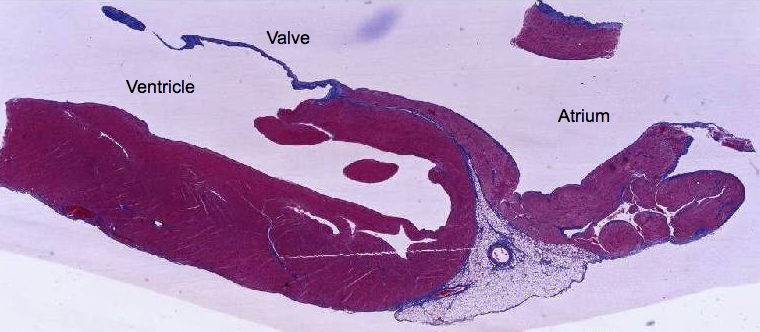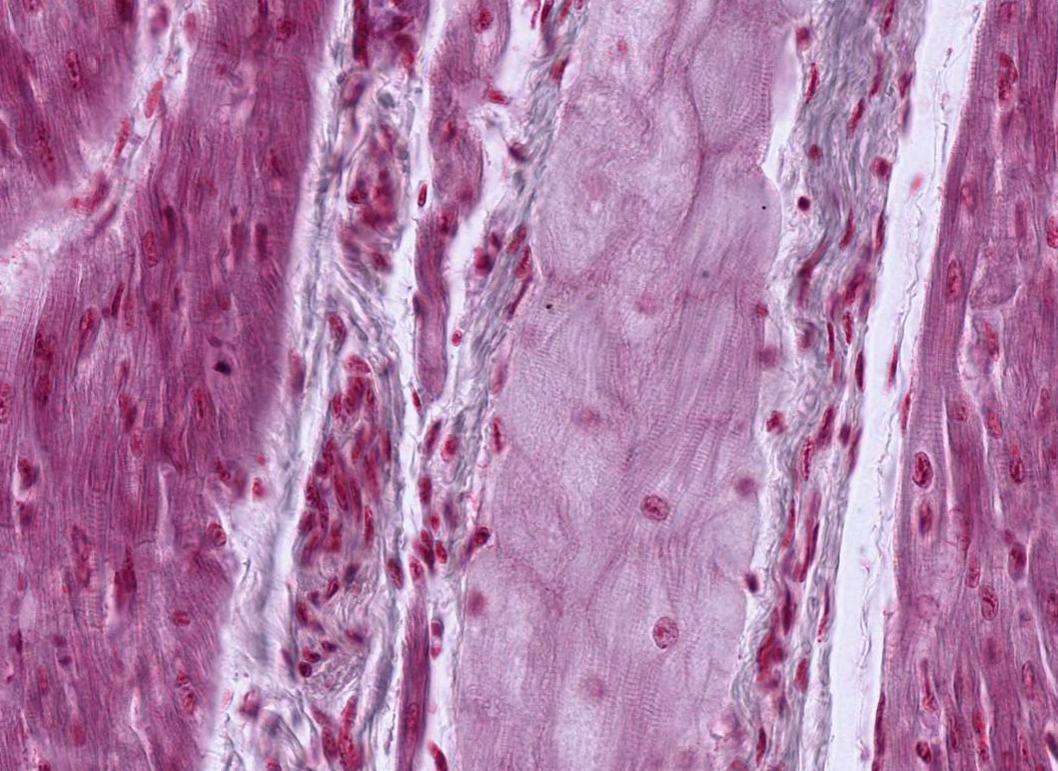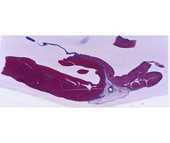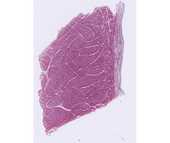The Heart

#17 Heart, Sagittal Section (Mallory-Azan)
 The epicardium includes a layer of simple squamous epithelium called the mesothelium and the underlying supportive connective tissue. The epicardium is the outermost layer surrounding the heart, and is comparable to the tunica adventitia of vessels. In the region of the atrium the epicardium contains fatty connective tissue and vessels of the coronary circulation.
The epicardium includes a layer of simple squamous epithelium called the mesothelium and the underlying supportive connective tissue. The epicardium is the outermost layer surrounding the heart, and is comparable to the tunica adventitia of vessels. In the region of the atrium the epicardium contains fatty connective tissue and vessels of the coronary circulation.
The distribution of blue-staining collagen fibers reveals the fascicle organization of the myocardium, which is comparable to the tunica media. In areas where muscle fascicles are longitudinally sectioned, note the intercalated discs that appear as red-staining step-like lines perpendicular to the long axis of the fiber. Is the myocardium thicker in the atrium or ventricle? Why?
The heart valves are extensions of the innermost layer, the endocardium. The endocardium contains an endothelium on their free surface and underlying supportive connective tissue. Use this slide to also study the structure of the arteries and veins of the coronary circulation.
#19 Heart, Ventricle (PTAH Stain)
 The impulse conducting system of the heart begins with the sinoatrial and atrioventricular nodes. Conduction continues through the atrioventricular bundle of His and into Purkinje fibers of the ventricles. Purkinje fibers are hypertrophied cardiac muscle fibers that are specialized for conducting an impulse rather than for contraction. They contain one or two nuclei, centrally situated in a pale staining mass of sarcoplasm that is rich in mitochondria and glycogen. Major branches of the bundle of His lie outside the myocardium in the subendocardium, as seen on the right side of this slide. Purkinje fibers traverse the myocardium where the terminal branches merge into muscle fascicles. This is seen in favorable longitudinal sections as a point where the Purkinje fibers become smaller, more densely stained and become indistinguishable from fascicles of muscle fibers. Individual muscle fibers are grouped in fascicles that are seen in both cross and longitudinal section on this slide. The fascicles are bounded by connective tissue containing blood vessels of the coronary circulation and nerve fibers.
The impulse conducting system of the heart begins with the sinoatrial and atrioventricular nodes. Conduction continues through the atrioventricular bundle of His and into Purkinje fibers of the ventricles. Purkinje fibers are hypertrophied cardiac muscle fibers that are specialized for conducting an impulse rather than for contraction. They contain one or two nuclei, centrally situated in a pale staining mass of sarcoplasm that is rich in mitochondria and glycogen. Major branches of the bundle of His lie outside the myocardium in the subendocardium, as seen on the right side of this slide. Purkinje fibers traverse the myocardium where the terminal branches merge into muscle fascicles. This is seen in favorable longitudinal sections as a point where the Purkinje fibers become smaller, more densely stained and become indistinguishable from fascicles of muscle fibers. Individual muscle fibers are grouped in fascicles that are seen in both cross and longitudinal section on this slide. The fascicles are bounded by connective tissue containing blood vessels of the coronary circulation and nerve fibers.

